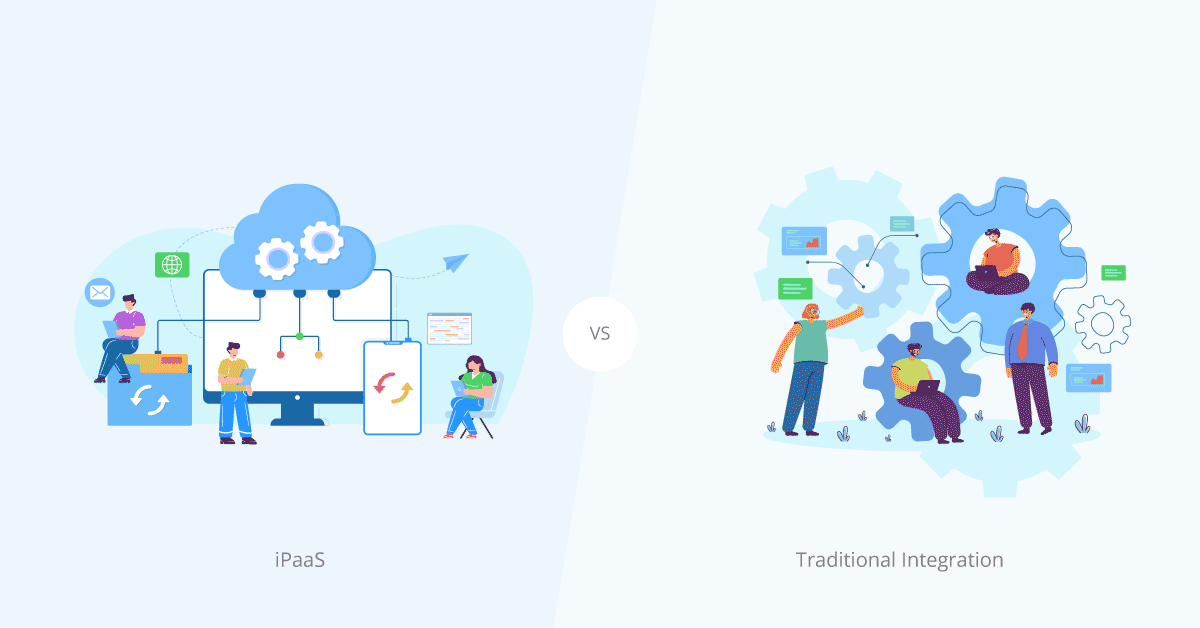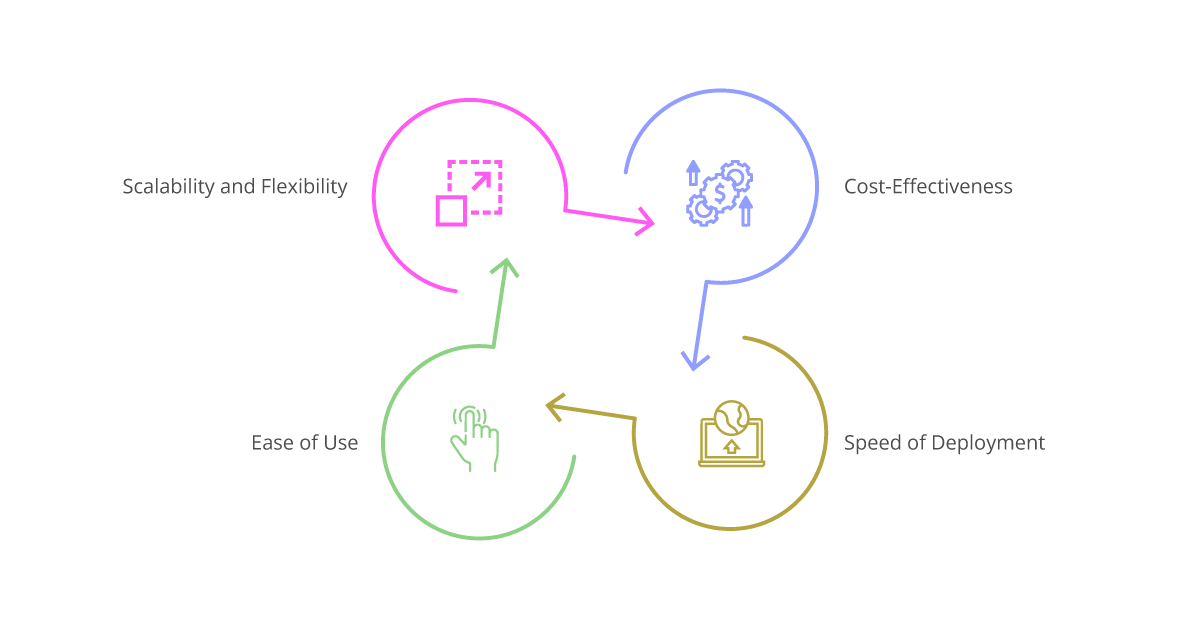Diverse systems and applications that drive their operations and growth have become one of the most pressing challenges for businesses. Additionally, the complexity of integration has also prompted companies to regard this area as complex and difficult. Over the years, traditional integration technologies and methods have consumed heavy resources and required complex infrastructure, involving hard-to-find experts. However, with the inception and growth of Integration Platform as a Service (iPaaS), this approach is no longer valid. This article will cover the differences between this technology and previous integration methods and see why cloud solutions are the future.
Aonflow iPaaS – Free for First 3 Months!
Build and run up to 1,500 transactions monthly with no cost. No payment info needed!
Understanding Traditional Integration.
Traditionally, businesses looking to integrate their disparate software platforms embarked on custom-built integration projects. These projects entailed the creation and ongoing maintenance of complex integration solutions created by implementing middleware or enterprise service buses.
Developing Custom Solutions. In the past, organizations would assemble teams of developers to build unique solutions customized to their specific integration requirements. Even before development could begin, companies needed to make a massive capital investment in the form of purchasing hardware, and software licenses for their integration infrastructure. In addition to the costs involved in developing these custom-built solutions, organizations incurred ongoing expenses in maintaining and updating support to ensure the systems’ smooth running.
Complexity and Long Timelines. Perhaps the defining features of traditional integration projects are their complexity and protracted development lifecycles. From the start of development until full implementation, integration projects typically take months or even years. Every aspect of traditional integration projects, from data mapping. Articulating the integration scope, timeline, and budget was challenging for organizations due to these features.
Example:
To illustrate the process, consider a multi-national corporation functioning in several geographically distinct regions of the world. The company employs a wide range of enterprise implementations to ensure the smooth workflow of business operations, relying on the corporation’s customer relationship management, enterprise resource planning, supply change management, and human capital management systems, among others.
The corporation decides to undertake a traditional integration project and connect all of these systems to a common network to simplify several business and data flows and improve visibility. The life-cycle of this project includes the analysis of existing systems and data flow and the eventual development of a custom integration mechanism that would allow all of the enterprise’s systems to communicate with one another.
Months pass as the team laboriously develops the integration, configures the data-flow schemes, and develops the middleware components that would allow for the transformation of data and its transfer between the corporate systems. Several unexpected challenges are encountered during the project design and implementation, including the compatibility of legacy systems, the formatting of different systems data, and the performance optimization of the integration mechanism.
However, the corporation carries on, and after meticulous testing and validation, the integration is eventually ready. Although the corporation successfully connects its systems and simplifies the data flow, the project loses the excess of time, capital, and effort.
The Rise of iPaaS
On the other hand, iPaaS provides a cloud-based integration method that eliminates most of the challenges in traditional integration pathways.
iPaaS represents a revolutionary approach to a wholly new way of linking systems and applications in a more agile, scalable, and economical manner. With it, a new age of efficiency, agility, and innovation is ushered in that is typified by cloud-based integration.
1. Cloud-Based Integration
Regarding traditional integration methods that rely on in-house infrastructure and customized tools, iPaaS benefits from the cloud’s strengths. iPaaS generally provides a cloud-based ecosystem in which companies may construct, deploy, and nurture integrations without massive hardware expense or infrastructure direction. By reducing the necessity to provision and maintain their integration infrastructure, iPaaS helps firms reduce complexity and expenses.
2. Pre-built connectors and APIs
The use and intelligence of pre-built connectors, APIs, and integration blueprints are among the critical elements of iPaaS. Pre-built connectors enable organizations to rapidly establish connections to a variety of applications, systems, and data sets. iPaaS platforms equip businesses to create new apps in a timelier manner.
3. Adaptability
iPaaS systems are developed to be scalable and adaptable, allowing businesses to improve their operations as necessary. iPaaS enables businesses to get what they need without the need to acquire hardware and tooling, which is a huge investment using a business subscription-friendly plan.
Example:
Consider the case of a rapidly growing software company specializing in cloud-based collaboration tools for businesses around the globe. As the company expands and acquires new clients, it encounters challenges in integrating multiple internal systems such as CRM, billing, and customer support platforms to optimize its operations and customer experience.
Through implementing iPaaS, the company could leverage the power of a full suite of pre-built connectors and integration templates to ensure seamless connectivity across its IT environment. Due to the subscription-based pricing model, integrated resources could be easily scaled as a company grows, promoting cost-effectiveness and resource efficiency.
As a result of an easily accessible and user-friendly interface and workflow, the company’s business users could actively participate in the integration process without the need for extensive IT resources, exerting project turnaround and savings. The company improved its performance, agility, employee satisfaction, and client service, enabling it to remain competitive in the software market.
Aonflow is the leading integration platform.
You can kick-start by integrating your first-ever workflow in just a matter of minutes.
Key Differences Between iPaaS and Traditional Integration
| Key Differences | Traditional Integration | iPaaS |
|---|---|---|
| Scalability and Flexibility | Traditional integration solutions often struggle to accommodate the dynamic needs of modern businesses, leading to scalability issues and performance bottlenecks. | iPaaS offers scalability and flexibility, allowing organizations to scale their integration capabilities on-demand and adapt to changing business requirements seamlessly. |
| Cost-Effectiveness | Traditional integration projects require significant upfront investment in hardware, software, and infrastructure, as well as ongoing maintenance and support costs. | iPaaS offers a subscription-based pricing model that eliminates upfront capital expenses and provides predictable, pay-as-you-go pricing. |
| Speed of Deployment | Traditional integration projects typically involve lengthy development cycles and complex deployment processes, often taking months or even years to implement fully. | iPaaS enables rapid deployment with pre-built connectors and integration templates, reducing time-to-market and accelerating time-to-value. |
| Ease of Use | Traditional integration solutions often require specialized technical expertise to develop, deploy, and maintain. | iPaaS platforms are designed with user-friendly interfaces and intuitive tools, enabling business users to participate in the integration process without requiring extensive technical knowledge. |
The integration process can be rapidly accelerated with iPaaS due to its compelling case over the traditional integration methods of scalability, cost-benefit, rapid application deployment, and attractive user experience. This enables organizations to reduce costs, enhance the speed of their integration projects, and innovate, to keep up with today’s business pace.
Making the Case for Cloud-Based Solutions
The competition space requires innovation and agility – it’s a competition where the track is getting altered rapidly, hence the enterprise needs to have the ability to adapt quickly to maintain a lead over their competition. This is where the cloud-based solution, including iPaaS, comes in handy – they provide a new era of integration process that enables the organization to connect systems and scale, all this at minimal expenditure and effort. First, imagine your enterprise as a city with different neighborhoods that represent a system or an app in an IT setting. iPaaS acts as bridges and highways that connect these neighbors, allowing data and events to flow with no obstructions. Moreover, IPaaS acts as a city planner who can reconstruct highways and construct new ones – the infrastructure can be adjusted based on the demand.
The move from a traditional integration approach to iPaaS may be compared to going from buying a house to renting an apartment. The traditional way of integration requires a large initial investment, and then the enterprise is obligated to conduct costly maintenance entirely disregarding the fact that the house loses value over the years. With renting, you are billed once a month, and the management company is responsible for everything to keep the apartment in good condition. The apartment management company with iPaaS will keep your maintenance costs down and enable you to settle on other important issues such as business improvement and customer satisfaction. Last, the traditional integration process is to purchase a new TV, IPaaS is an update giving you not only a wide-screen TV, but a home theater, cinema theater, electric guitar, unlimited movie subscription, and pizza. With iPaaS, the enterprise will have more opportunities and free time, and thus will not be able to utilize iPaaS only for their business growth.
Conclusion: A breath of fresh air in Integration
iPaaS cloud-based solutions breathe fresh air into the world of integration. Integration with them is easier, faster, cheaper, more affordable, and more available than ever before. iPaaS is integration as it never was – unlimited, boundless, and easily scalable. By choosing iPaaS, you choose infinite possibilities and new horizons for digital transformation. It’s like having a good and reliable, old and new, experienced old friend who will help you with all the challenges, allow you to hold onto all the opportunities, and open up new horizons for growth. So why wait? Start using Aonflow iPaaS today and start growing.
Aonflow iPaaS – Free for First 3 Months!
Build and run up to 1,500 transactions monthly with no cost. No payment info needed!


